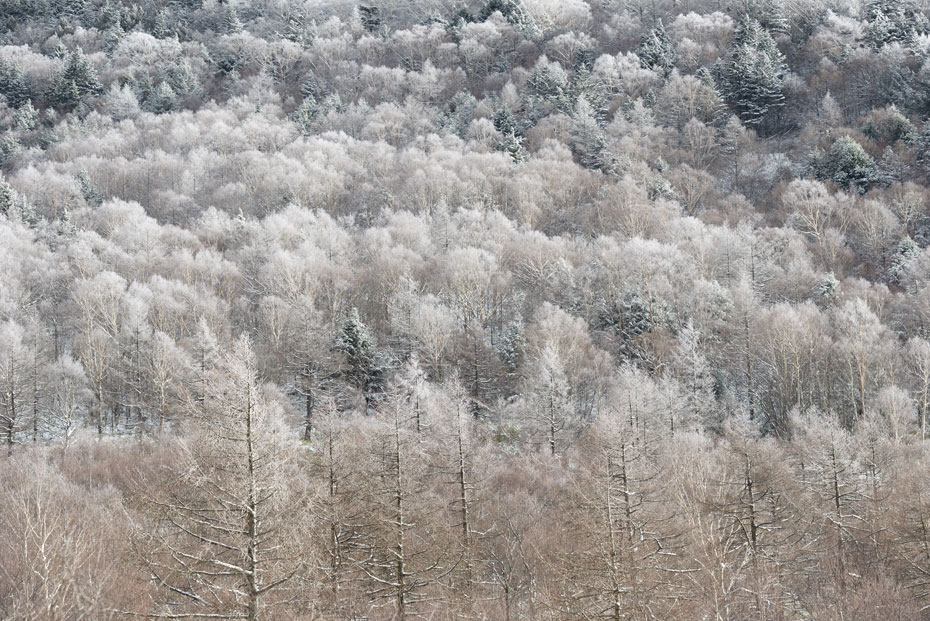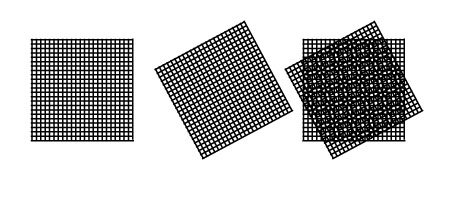Moiré & False Color
What is Moiré?
When we take a photograph of a subject that has a pattern, the image will sometimes show moiré, which is simply a new pattern that is created when two patterns overlap. In such an example, the subject is the first pattern, and the image sensor adds the second pattern. The third pattern is the moiré.
Notice in the illustration below, the round, circular patterns (on the right) created as the two grids are combined; this is moiré.
(l. to r.) Pattern 1, Pattern 2, Moiré
Subjects that contain a fine regular pattern such as a woven textile, fine pieces of hair, or scenes containing repetitive details, such as strong vertical lines in architecture, will more commonly experience moiré.
The reason a D-SLR camera will create moiré is that it uses a very small pattern of red, green and blue filters over the individual pixels to record color. When a photograph is taken, each pixel is exposed to one color and the camera calculates the information that is remaining. The small pattern of filters is what causes moiré.
Color that is not present in the object itself, or introduced into the shot by the set lighting is known as false color. False color, like moiré can be introduced into an image—as an artifact that will detract from the overall image if not corrected. False color can be introduced with the moiré pattern or on its own.
This can be reduced in post processing, however, it is always better to correct in the camera, which is why Nikon includes an Optical Low Pass Filter (OLPF) in most of its D-SLR cameras.
The role of the optical low pass filter
In many D-SLRs an OLPF—also known as an anti-aliasing filter—prevents false color and moiré that can ruin a picture. The trade-off to using an OLPF is slight softening of the image. To counteract the softness, in-camera sharpening is used and can be further adjusted by the end user. In addition, photographers who shoot the NEF (Nikon Electronic File) RAW file format can add more sharpening in post-production.
Nikon’s D800 D-SLR utilizes an optical low pass filter to counteract the possibility of moiré or false color in your digital photographs. The D800E model does not utilize the OLPF that prevents false color and moiré. This means that compared to the D800, the D800E carries an increased possibility that moiré and false color will appear. The benefit to photographers in using the D800E is a slight increase in resolution and sharpness. To take advantage of this slight increase in sharpness and resolution, some adjustments to shooting style (hand-held vs. tripod mounting), technique, lens choice and aperture must be considered.
For the vast majority of photographers who shoot a wide variety of subjects, shoot hand-held as well as with a tripod, use a selection of NIKKOR lenses and shoot at all aperture settings, the D800 and its 36.3MP using the OLPF will be the ideal choice.
For a few specific types of photographers—studio, commercial and still life—who have used medium or large format cameras, the D800E, for instance, will be the right camera for their needs. These photographers can control light, distance, aperture selection and their subjects to the degree where they can reduce the occurrence of moiré. This is because medium and large format digital cameras do not utilize an OLPF, and so photographers who shoot with them already have a working understanding of the added workflow needed to counteract or correct for moiré/false color. These photographers understand that extra time will be needed in the creation of each image, whether it is by solving any issues of moiré/false color during the shooting process, in processing the RAW image files, or using software to fix the image files.
Example of the difference in sharpness between the D800 and D800E. The increased resolution of the D800E is slight.
Another example of the difference in sharpness between the D800 and D800E. The increased resolution of the D800E is slight.
A third example of the difference in sharpness between the D800 and D800E. The increased resolution of the D800E is slight.
You can alter your shooting style to accomodate for changes that may be neceessary to keep moiré/false color to a minimum. (see sidebar at end of article). Because you won’t easily be able to see the effects of moiré/false color on the camera’s LCD, you should be viewing the image at 100% magnification on a computer screen to see the artifacts in the image. Nikon Capture NX2 software provides a way to correct the false color moiré in images.
It is important to note that if you shoot predominantly JPG or TIFF formats, the D800E is not the best choice for you—the D800 is. Once the moiré/false color is visible in a JPG or TIFF file, you may not be able to reduce the effects, even with software because these files are processed in-camera. The best way to improve an image that shows moiré/false color is to shoot RAW and fix it during post production, when the image file is processed.
An example of moiré and false color can be seen in the kimono fabric in the image that was captured with the D800E.
Minimizing Moiré & False Color in the D800E $
There are a few things that you can do to minimize the false color and moiré that is inherent in a camera that does not incorporate an optical low pass filter. The best way to solve the problem is to fix the shooting situation before the image is captured.
-
Since the angle of the camera and subject causes moiré, slightly changing the angle of the camera (by rotating the camera) can remove or change any moiré that is present.
-
Changing the angle relationship by moving left or right, up or down can reduce moiré.
-
Moiré is caused by very sharp focus and high detail on fine patterns; slightly changing the focus point changes the sharpness and can help to remove moiré.
-
Different lenses or focal length settings can be used to alter or remove moiré.
-
Stop the lens down about 3 f/stops from its maximum aperture. This requires you to shoot around f/5.6 or f/8 all the time. Stopping the lens down to a smaller aperture (such as f/11 or f/16) will cause diffraction to lower the sharpness, reducing the benefit of the OLPF. This will easily negate the benefits of the D800E.
-
You can remove the false color in post-production, on the computer easier than you can the moiré pattern itself. Nikon Capture NX2’s moiré reduction tool for NEF (RAW) files may be able to remove some or all of the color moiré that does appear in the final image.











